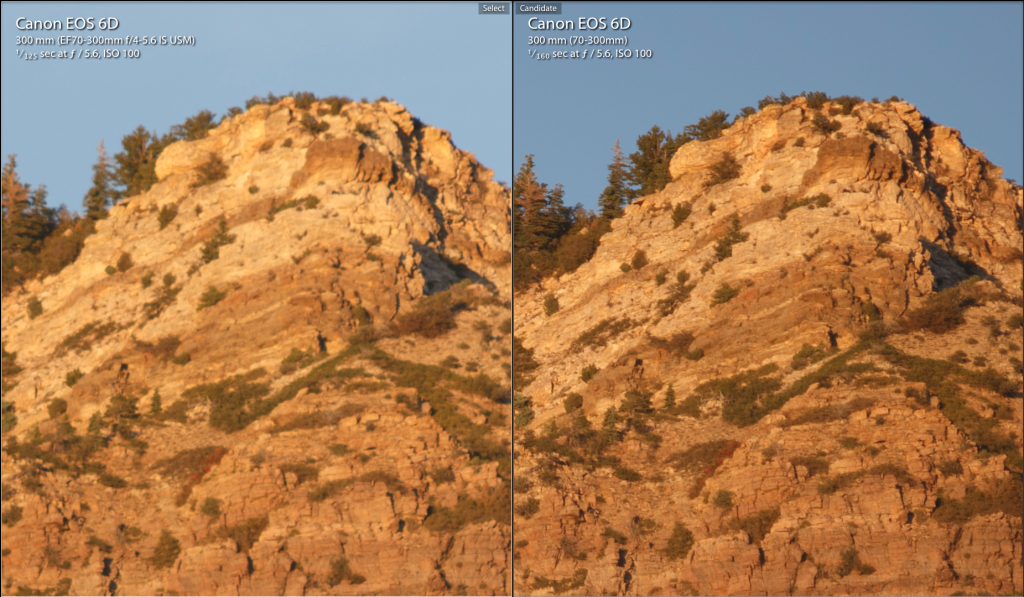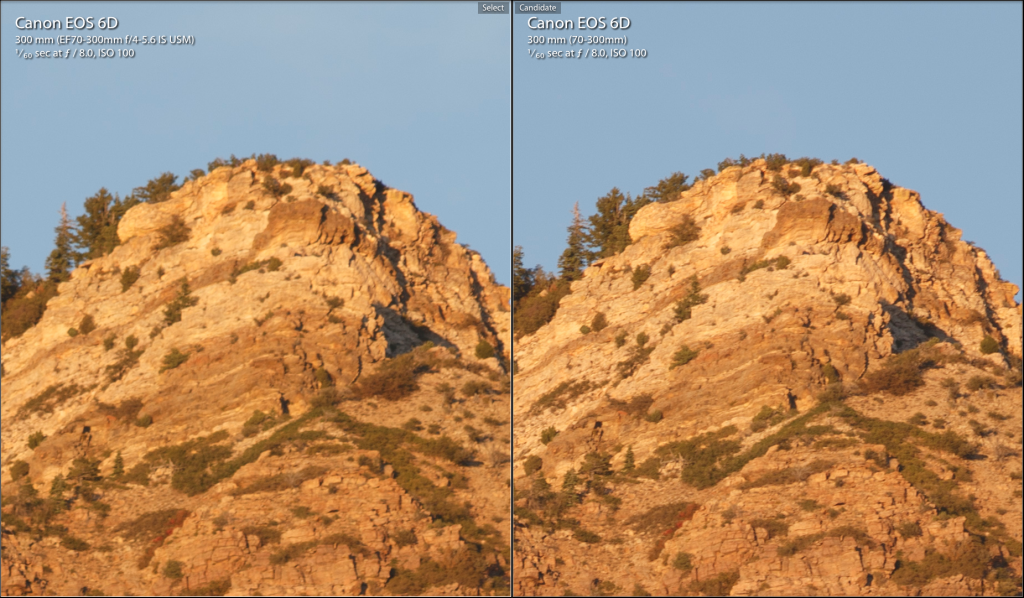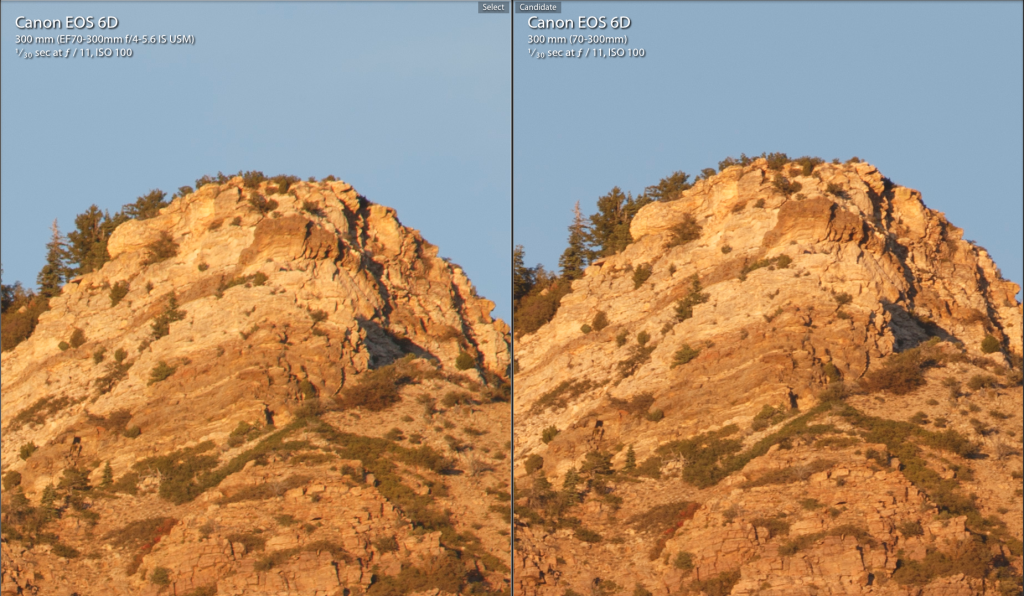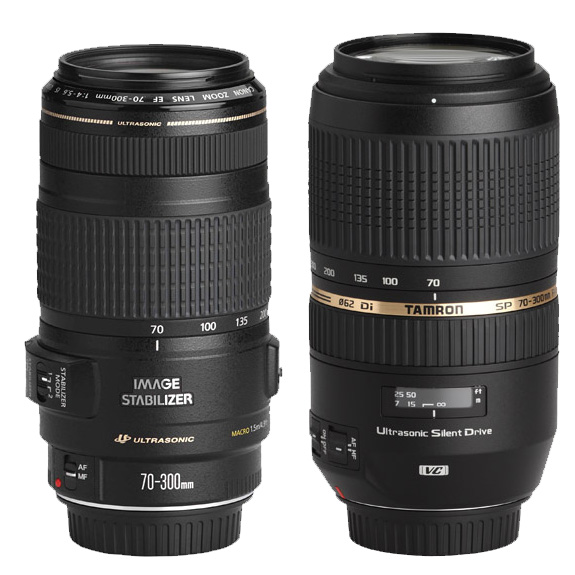One question I am frequently asked is how does the Tamron 70-300mm f/4-5.6 VC USD compare with the Canon EF70-300mm f/4-5.6 IS USM. The answer is “extremely well”. But don’t take my word for it, look at these purely non-scientific examples for yourself. These images were shot with my Canon EOS 6D camera on a tripod using mirror lockup and a 2 second delay remote release for the best possible quality. The exposure settings were the same, shot in aperture priority, with my white balance set to 5600k, and no post processing applied to the RAW images. I set them up in my Lightroom using the compare mode and grabbed screen shots for the comparison.
First, here is the full image shot at 300mm with both lenses (click to see larger):

Image Quality
For this series of comparison images I have zoomed in to 100% at the top of the mountain peak. The first comparison is both lenses (Canon on the left and Tamron on the right) shot wide open (f/5.6):

At f/5.6 the Tamron appears to be slightly sharper. In the next example both images were shot with the lens stopped down to f/8:

At f/8 the difference is not as great between the two lenses. For the final comparison both images were shot at f/11:

At f/11 both lenses appear to give about the same image quality. I only did the test at 300mm because in my opinion 300mm is the reason you buy a 70-300mm lens, otherwise you would purchase the Canon 70-200mm f/4 L IS instead, right? But image quality is not the only factor you should consider when comparing lenses (although it is one of the highest priorities for most photographers). I also like to consider the build quality, autofocus and Image stabilization between the lenses.
Build Quality
Overall both lenses feel about the same. The Tamron is slightly larger and uses a 62mm filter vs a 58mm for the Canon. Both lenses feel reasonably well constructed, using high quality plastic for the outer shell, and have a metal lens mount. The Tamron zoom ring turns the opposite direction of the Canon, and features a distance scale, where the Canon does not. Additionally, the Tamron includes a dedicated petal shaped lens hood while Canon charges you an additional $30 for theirs. Overall I would give the nod to Tamron simply because of the included lens hood. I wish that Tamron used a 67mm filter instead of 62mm since Canon does not have any lenses that use a 62mm filter (and Nikon doesn’t have too many that do, either).
Autofocus
Here the Tamron wins hands down. The Canon lens uses a variant of their USM focusing motor, but it is not a true ring type USM. The focus ring turns during autofocus operation, and you do not have the option of full time manual focus override. Instead you have to flip the AF/MF switch to the “MF” position or you can damage the focusing motor. The Tamron not only features full time manual focus override, but it also focuses quieter and slightly faster than the Canon in my testing. The speed difference is not big, but it is noticeable. Also, the Tamron is internally focused which makes using a polarizing filter much easier.
Image Stabilization
Again, I think both systems are pretty close and it is hard to call a clear winner. The Tamron does show a bigger initial jump before it locks down than the Canon, which is a little disconcerting at first for some photographers, but in the end both systems work equally well.
The Bottom Line
Both lenses are good examples of consumer designed and built 70-300mm zooms. Which one you get is ultimately your decision, but if it were me, for the $200 price difference, I feel like the Tamron is a much better value than the Canon. The Tamron is not only less expensive, but also includes a dedicated lens hood, making the value that much better. Image quality between the two lenses is pretty much the same based on my testing, as is the image stabilization system found in each lens, but the real slam dunk for me is the Autofocus. The Tamron is a much better implementation than the Canon in this regard. So my advice would be to get the Tamron and use the $230 you save to get other lenses or accessories for your camera.
Specifications
| Canon |
Tamron |
|
| Focal Length: | 70-300mm | |
| Aperture Range: | f/4.0-5.6 (max) / f/22-32 (min) | f/4.0-5.6 (max) / f/22-32 (min) |
| Lens Construction: | 10 Groups / 15 Elements | 12 groups / 17 elements |
| Angle of View (Diagonal): | 34° – 8° 15′ | 34°21′ – 8°15′ |
| Filter Rotation: | Yes | No |
| Minimum Focus Distance: | 58.8 in (1.5m) | 59.05 in (1.5m) |
| Filter Size: | 58mm | 62mm |
| Image Stabilization: | Yes | Yes |
| Lens Hood Included: | No | Yes |
| Lens Case Included: | No | No |
| Dimensions (Width x Length): | 3.0 in. x 5.6 in. (76.5mm x 142.8mm) | 3.21″ x 5.6″ (142.7mm x 81.5mm) |
| Weight: | 22.2 oz (630g) | 26.98 oz (765g) |
| Price: | $649 | $449 |
Buy from Amazon
You purchase using these links helps to support this website. Thanks!!

